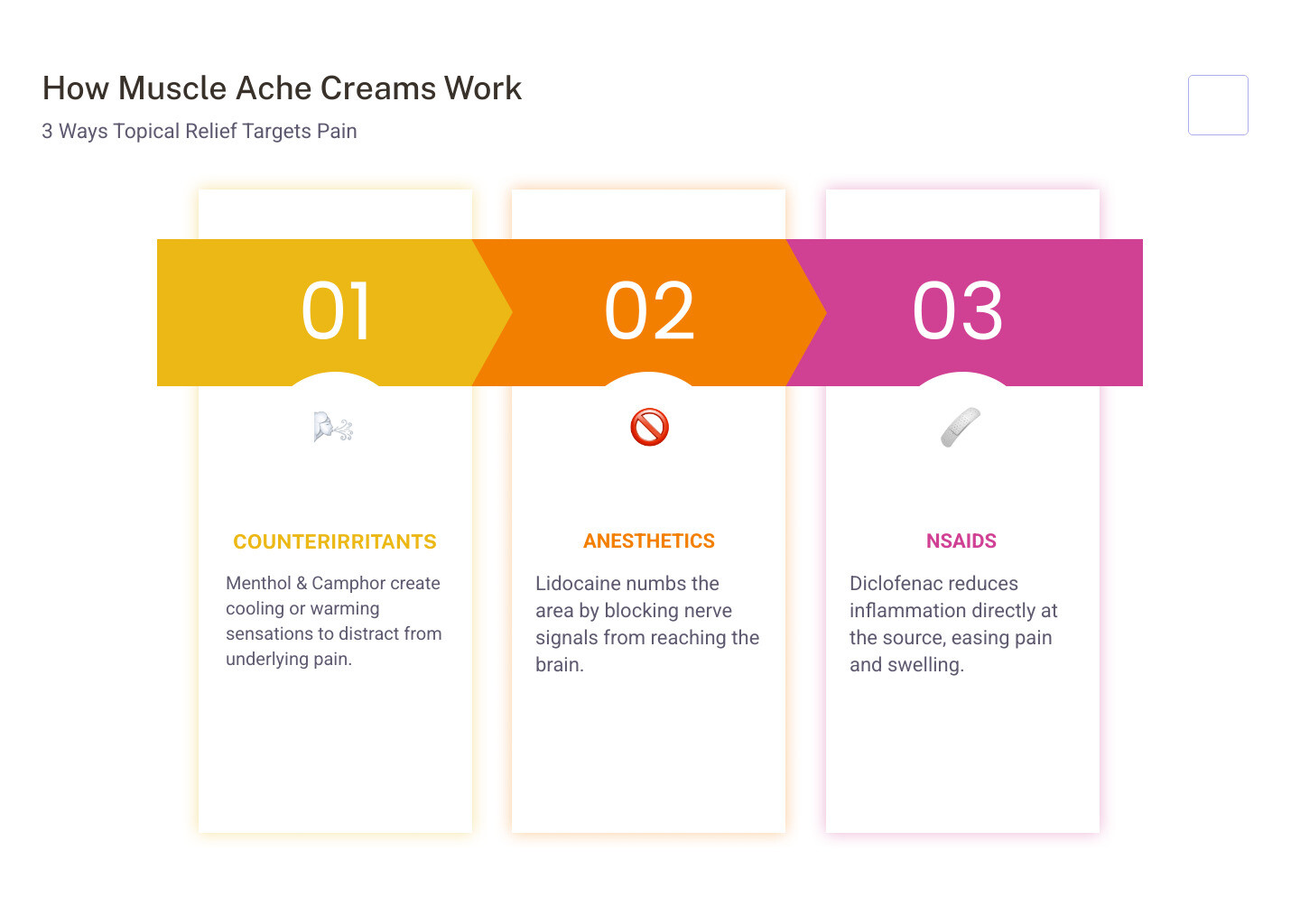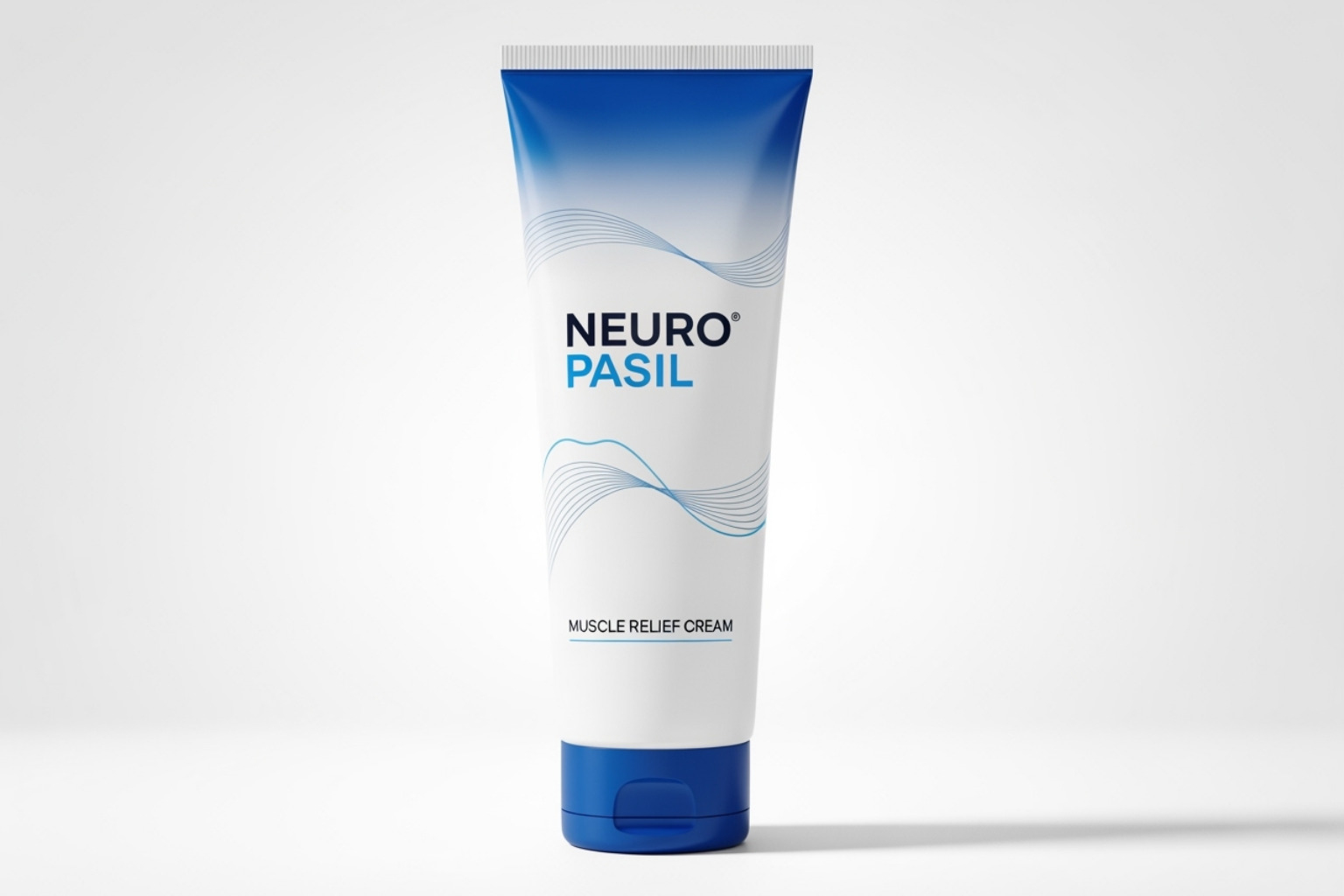Your Guide to Soothing Sore Muscles
The best muscle ache cream delivers fast, effective relief by targeting pain signals at the source. Whether you're dealing with post-workout soreness, chronic joint stiffness, or nerve-related discomfort, these creams work by interfering with pain signals traveling from your muscles to your brain. Research shows that topical analgesics can significantly reduce pain.
The key is understanding how different ingredients work. Counterirritants like menthol and camphor create cooling or warming sensations that distract your nervous system from the underlying pain. Anesthetics like lidocaine numb the area by blocking nerve signals, while NSAIDs like diclofenac tackle inflammation directly.
Not all muscle aches are the same. Acute injuries often respond best to cooling creams, while chronic stiffness may benefit from warming formulas. Most topical pain relievers take 30 to 60 minutes to become fully effective, so patience is key.
I'm Tony Enrico, and I've spent years helping people find natural, fast-acting solutions for muscle and nerve pain through Neuropasil's advanced formulations featuring ingredients like menthol, aloe, and urea. My goal is to help you make informed decisions about the best muscle ache cream for your needs so you can get back to doing what you love, pain-free.

How to Choose the Right Muscle Ache Cream
Walking down the pain relief aisle can be overwhelming. Finding the best muscle ache cream isn't about the flashiest package—it's about understanding what's inside and how it matches your specific type of pain. Different ingredients work through different mechanisms, so let's break down what really matters.
What to Look for in the best muscle ache cream: Key Ingredients
The active ingredients are where the magic happens. Here's a look at the most common and effective types.
Counterirritants create a sensation, like cooling or warmth, that distracts your brain from the underlying ache.
- Menthol provides a cooling, tingly sensation. Research shows that menthol slows blood flow and cools the skin, which can help reduce inflammation while distracting from pain. It's a key ingredient in Neuropasil's natural formula.
- Camphor works similarly, creating cooling or warming sensations.
- Methyl salicylate (wintergreen oil) brings gentle heat and has mild anti-inflammatory properties.
- Capsaicin, derived from chili peppers, creates an intense warming sensation that can deplete the neurotransmitters that carry pain signals.
Anesthetics take a more direct approach by numbing the area. Lidocaine is the primary ingredient in this category, blocking nerve signals at the source. Studies on topical lidocaine show its effectiveness for various types of localized pain, including neuropathy and chronic back pain.
NSAIDs (nonsteroidal anti-inflammatory drugs) in topical form deliver anti-inflammatory power directly where you need it. Diclofenac is a common topical NSAID that inhibits enzymes that trigger inflammation and pain, making it effective for localized arthritis and muscle strains according to research on topical NSAIDs.
Natural ingredients are increasingly backed by modern research.
- Arnica has been used for generations to soothe bruises and inflammation. Studies suggest arnica has anti-inflammatory properties useful for osteoarthritis and muscle soreness.
- CBD (cannabidiol) interacts with the body's endocannabinoid system to help regulate inflammation and pain perception.
- Emu oil and MSM (methylsulfonylmethane) are other natural compounds with anti-inflammatory properties that support joint and tissue health.
Cooling vs. Warming Creams: What's the Difference?
The choice between cooling and warming is about matching the sensation to your situation.
Cooling creams, featuring ingredients like menthol and camphor, are best for acute pain like fresh muscle strains or post-workout soreness. The icy sensation numbs the area and causes vasoconstriction (narrowing of blood vessels) to help reduce swelling.
Warming creams, with ingredients like capsaicin, are ideal for chronic pain and stiffness. The heat increases blood flow (vasodilation), helping to relax tight muscles and ease the discomfort of arthritis or chronic back pain.
| Feature | Cooling Creams | Warming Creams |
|---|---|---|
| Primary Sensation | Icy, numbing | Hot, relaxing |
| How It Works | Causes vasoconstriction, reduces blood flow | Increases blood flow (vasodilation), relaxes muscles |
| Best For | Acute injuries, sprains, post-workout soreness | Chronic pain, stiff joints, arthritis, muscle tightness |
| Key Ingredients | Menthol, Camphor | Capsaicin, Methyl Salicylate |
Creams, Gels, Sprays, or Patches?
The delivery method affects your experience.
- Creams are thick and ideal for massaging into larger areas.
- Gels are lightweight, absorb quickly, and are less greasy.
- Sprays are great for hard-to-reach areas like your back.
- Patches offer continuous, long-lasting relief without reapplication.
- Balms are thick, waxy, and create a protective barrier, excellent for deep massage.
Your choice depends on the location of your pain, your lifestyle, and your personal preference.
Why Neuropasil is a Premier Choice for Pain Relief

After exploring the science of topical pain relievers, it's clear that the right combination of ingredients is crucial. This is where Neuropasil stands out. Our unique formula was specifically created to address a wide spectrum of pain, from general muscle soreness to complex nerve-related discomfort.
What sets Neuropasil apart is its synergistic blend of natural, effective ingredients. We combine the healing properties of Aloe Vera and Urea with the cooling distraction of Menthol to provide fast-acting, targeted relief.
This formulation is why Neuropasil has become a trusted companion for thousands of customers dealing with:
- Nerve Pain: From the shooting pain of sciatica to the burning sensations of neuropathy and the widespread aches of fibromyalgia.
- Joint & Muscle Discomfort: Soothing the sharp discomfort of plantar fasciitis, easing joint stiffness, and relieving back and neck pain.
- Athlete Recovery: Helping athletes recover from intense training by treating sore muscles, cramps, and aching feet.
The formula absorbs quickly without leaving a sticky, greasy residue, making it pleasant and convenient to use anytime. It's a soothing, effective solution made with ingredients you can feel good about. We've heard countless stories from loyal customers who found relief with Neuropasil when other products fell short, and that's what drives our mission to provide superior, natural pain relief.
How to Use Muscle Ache Creams Safely and Effectively
To get the most from your chosen cream, proper application and safety are paramount. Follow these best practices for effective and safe relief.
Application Best Practices
- Read the Label: Always follow the product's specific instructions on frequency and amount.
- Perform a Patch Test: Before full use, apply a small amount to your inner forearm and wait an hour to check for irritation, especially if you have sensitive skin.
- Apply a Thin Layer: More is not better. Gently massage a thin layer into the skin until fully absorbed.
- Wash Your Hands: Thoroughly wash your hands after every application to avoid accidentally touching your eyes or face.
- Use on Unbroken Skin Only: Never apply creams to cuts, scrapes, or open wounds, and keep them away from eyes and mucous membranes.
Potential Side Effects and Precautions
While generally safe, topical creams can have side effects. The most common issue is minor skin irritation, such as redness or itching. Allergic reactions are rare but possible, which is why a patch test is so important.
A critical safety rule: Never use muscle ache creams with a heating pad. Combining warming creams with an external heat source can intensify the effect to dangerous levels, potentially causing severe skin irritation or burns. As Dr. Derek Ochiai emphasizes, caution with application is key.
See a doctor if your pain is sudden, severe, or persists for more than a few days. Topical creams are for temporary relief, not a cure for underlying injuries. If you experience a severe reaction like blistering or excessive pain, stop use and contact your healthcare provider.
Frequently Asked Questions about Muscle Ache Creams
When you're in pain, you want answers fast. Here are the straight facts on the most common questions about topical pain relievers.
How long does it take for muscle ache cream to work?
While you might feel an initial sensation right away, most topical pain relievers take between 30 and 60 minutes to reach their full effectiveness. The active ingredients need time to absorb through the skin to the underlying tissues. The exact timing can vary based on the ingredients, your skin type, and the application area.
Can I use muscle ache cream for conditions other than sore muscles?
Yes. The best muscle ache cream options are often versatile. They are commonly used for:
- Arthritis: Creams with NSAIDs or natural anti-inflammatories like arnica can reduce joint inflammation.
- Nerve Pain: Lidocaine-based creams can numb areas affected by neuropathy or sciatica. Our Neuropasil customers report significant relief from various nerve-related conditions.
- Other Pains: Many find relief for joint stiffness, carpal tunnel syndrome, and chronic back pain.
Always check the product label to ensure it's appropriate for your type of pain.
Do muscle ache creams actually heal the muscle?
No, and it's important to understand their role. As physical therapist Dr. Brad Whitley explains, topical relievers don't heal tissue. They work by interfering with pain signals sent to your brain, a concept known as the gate control theory of pain.
They create sensations that distract your nerves or block pain signals entirely. While they don't fix the injury, they provide valuable temporary relief. This relief can help you sleep, stay mobile, and perform gentle movements that aid in the actual recovery process. They are excellent pain managers, but rest and time are still essential for healing.
Find Your Relief and Get Moving Again

We've covered how to choose the best muscle ache cream by understanding what's inside the tube. Your pain is personal, and the right solution depends on your needs—whether it's a cooling sensation for an acute injury, gentle warmth for chronic stiffness, or targeted relief for nerve pain.
The science is solid: topical creams work by interrupting pain signals, giving you the freedom to move more comfortably and get back to your life. While they don't heal the underlying issue, they provide the crucial relief needed to manage your day.
Remember the basics: read the label, do a patch test, and never combine warming creams with heating pads. If pain is severe or persistent, consult a healthcare professional.
At Neuropasil, our mission is to provide natural, fast-acting solutions. Our unique blend of Aloe, Urea, and Menthol delivers targeted, soothing relief for everything from neuropathy and sciatica to everyday muscle soreness. The power to control your comfort is in your hands.
Don't let aches and pains keep you on the sidelines. Explore Neuropasil's natural pain relief creams and experience the difference that targeted, soothing relief can make.
References / Sources
We've drawn from respected medical journals and research institutions to bring you accurate, science-backed information. Here are the studies and clinical resources that informed this guide:
Clinical Research on Topical Pain Relief
The effectiveness of topical analgesics is well-documented. The Cochrane Review on topical analgesics for acute and chronic pain provides a comprehensive analysis, and further research on topical preparations for pain relief confirms their efficacy.
Active Ingredient Studies
- Arnica: Research in Nutrients examines arnica's anti-inflammatory properties.
- Lidocaine: Studies in Drug Design, Development and Therapy demonstrate its effectiveness for various pain conditions.
- NSAIDs: We referenced research on topical NSAIDs and their role in reducing localized inflammation.
- CBD: A 2019 trial in the Journal of Pain Research showed its potential for pain reduction.
- Emu Oil & MSM: The anti-inflammatory properties of emu oil and MSM's ability to reduce inflammation are documented in scientific literature.
Expert Medical Opinions
We consulted with leading pain management specialists to ensure our recommendations reflect current medical practice:
- Dr. Derek Ochiai, MD, a sports medicine doctor and orthopedic surgeon at Nirschl Orthopaedic Center.
- Dr. Francisco Contreras, MD, director of Oasis of Hope Medical Institute.
- Brad Whitley, PT, DPT, XPS, a founding physical therapist of Bespoke Treatments San Diego.













